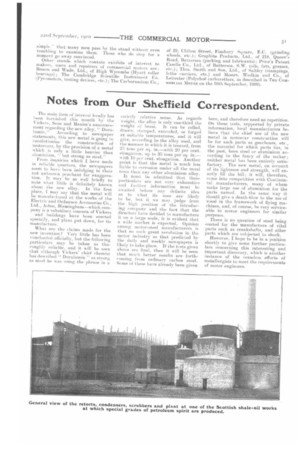Notes from Our Sheffield Correspondent.
Page 7

If you've noticed an error in this article please click here to report it so we can fix it.
The main item of interest locally has been furnished this mouth by the Vickers, Sons and Maxim's announcement regarding the new alloy, " Duna According to newspaper statements, this new metal is going to revolutionize the construction of motorcars, by the provision of a metal which _ is only a little heavier than aluminium, " but strong as steel." From inquiries which I have made in reliable quarters, the newspapers seem to have been indulging in their not unknown penchant for exaggeration. It may be as well briefly to note what little is definitely known about the new alloy. In the first place, I mar say that the metal will be manufactured at the works of the Electric and Ordnance Accessories Co., Ltd., Aston, Birmingham—which company is a subsidiary concern of Vickers and buildings have been erected specially, and plant put down, for its in anti fact ore.
What are the claims made for the new invention? Very little litt.s been vouchsafed officially, but the following partiedlars may be taken as thoroughly reliable, and it will be seen that although Vickers' chief chemist has deseribed " Duraln min " as strong as steel he was using the phrase in a strictly relative sense. As regards weight, the alloy is only one-third the weight of brass. It can be rolled, drawn, stamped, extruded, or forged at suitable temperatures, and it will give, according to the alloy used, and the 11111111101' in which it is treated, from 25 tons per sq. in.—with 20 per cent. elongation, up to 35 tons per sq. in.— with 10 per cent. elongation. Another point is that the metal is ninth less liable to eorrosion under all the usual tests than any other aluminium alloy.
It must be admitted that these particulars are not very exhaustive and further information must be awaited before any definite idea as to Nt bat its uses are likely to be, butt if we may judge from the high position of the introducing company and the fact that the dim-utters have decided to manufacture it on a large scale, it is evident that a wide market is expected. Opinion among motor-steel inanufacturers is that no such great revolution in the motor industry as that predicted by the daily and weekly newspapers is likely to take place. If the tests given above are final, then it will be seen that much better results are forthcoming from ordinary earbon steel. Some of these have already been given here, and therefore need no repetition. On these tests, supported by private information, local manufacturers believe that the chief use of the new metal in motorcar construction will he for such parts as gearboxes, etc., the material for which parts has, in the past, been steel or aluminium according to the fancy of the maker ; neither metal has been entirely satisfactory. The new metal, on account of its lightness and strength, will exactly fill the bill: it will, therefore, Clime into competition with Continental manufacturers, many of whom make large use of aluminium for the parts named. In the same way it should give a death-blow to the use of wood in the framework of flying machines, and, of course, he very serviceable to motor engineers for similar purposes.
There is no question of steel being ousted for the manufacture of vital parts such as crankshafts, and other parts which are subjected to shock.
However. I hope to be in a position shortly to give some further particulars concerning this interesting and important discovery, which is another instance of the ceaseless efforts of metallurgists to meet the requirements of motor engineers.
























